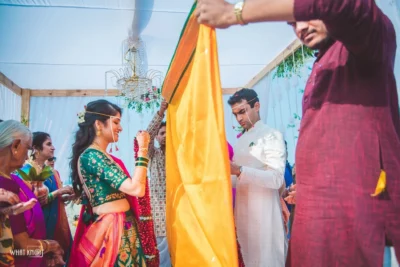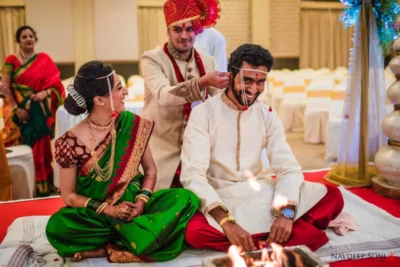
Simplicity and serenity beautifully resonate with the auspiciousness of a Maharashtrian wedding. Embellished with mogra and gulab patti — the ceremony is filled with the fragrance of the blossoming flowers and age-rich traditions. The exquisite nine yards of paithani silhouette and the richness of a peshwa pagdi or royal pheta symbolise the saffron dynasty’s valorous imprint on Indian history. Even though Marathi weddings are known for being simple, each ritual carefully cradles a deeper meaning from its glorious history.
The ceremonies slightly differ for konkanastha brahmins, deshastha brahmins and other Maratha clans. Each lineage has its own set of customs that may seem like a polite upgrade in changing times, but the spirit behind them remains the same.
The commemoration begins with lagnach bedi where a suitable match is found. Since the advent of love marriages, this ceremony is rarely witnessed. Once their hearts match, the only step left to do is to match their stars. This ceremony is more commonly referred to as patrika milan or guna milan. The guna is an attribute the boy and girl have compared to evaluate whether most of their traits match or not, much like a modern-day compatibility chart. With 16 or more matching guna, it is considered an ideal match, again dependent on the priority of attributes. In a broader sense, the attributes like health, happiness and children are given the utmost importance.
Once the couple is deemed compatible, a baithak is scheduled for discussing the shubh muhurat. Like most Indian weddings, Maharashtrian weddings hold the deepest regard towards the shubh muhurat and feel all auspicious events should tend to the same. And so it begins— the ceremonious events that unite not just two people but two families in the sacred bond of love and mutual respect.
Pre-wedding Rituals
Sakhar Puda

Translating to a sugar packet, the sakhar puda ritual symbolises the age-old belief of starting an auspicious event with a bite of something sweet. Held a few days before the wedding, sakhar puda entails the acceptance of the bride and groom by the elderly of the family. The bride’s arms are adorned with beautiful green bangles, and the groom’s mother applies haldi kunku, showering upon blessings of a happy and healthy life. The bride also receives a saree from the groom’s mother with a packet of sakhar puda. The bride’s mother applies kumkum tilak on the foreheads of the groom and his father. Some families go forward by exchanging rings, but it is not compulsorily a part of the ceremony.
Kelvan

The kuldevta in every region is seen as a guiding force for a happy grihasta life. Similarly, Maharashtrians believe in giving bountiful regards to the deity before moving forward. Kelvan is a pooja involving the intimate family, asking for the blessing of their kuldevta so that things run smoothly at the wedding.
Haldi Uthpam

The haldi uthpam ceremony denotes detoxification with the goodness of turmeric and mango leaves. The paste is ground on an iron mortar and pestle — applied on the groom’s face and feet to give him an extra glow for his big day. Later, the same paste is taken to the bride for her haldi ceremony. She is showered with love and cold water by her friends. As she sits on the stool, all female members have a gala time singing songs and tapping happy feet.
After the haldi is applied, the bride and groom cannot leave their houses until marriage or see each other as it is considered bad luck.
Wedding Day Rituals
 Seemant Pooja
Seemant Pooja

The groom’s family generously reciprocates by presenting the bride with gifts like perfume, jewellery and vanity gifts.
Ganpati Poojan
Ganpati Poojan holds a significant place in the hearts of Maharashtrian families. On the wedding day, it is considered auspicious to proceed with the blessings of Bappa. Everyone in the family comes together early in the morning for aarti on this joyous occasion, and the deity is presented with betel nut and a handful of rice grains. It is believed that singing the hymns of this aarti protects the families from any nirvighana or obstacles they might encounter along the way.
Gawrihar Pooja
This pooja is performed for the bride as she prays to goddess gowri for a prosperous life. She adorns her wedding attire and sits on a chaurang while the groom is welcomed in another room by suhasinis (married women).
Antrapat

Kankana Bandhana
The brother and male members of the bride’s family draw a cotton thread around the couple, forming four corners, symbolising a protection layer that covers the couple from all sides. The cotton thread is tied with turmeric tuber by the priest and is believed to ward off any evil spirit.
Lajahoma

After sitting down, the groom finalises the wedding with the mangalsutra and the sindoor. The air is filled with emotions, as that heartwarming gestures symbolise their unconditional acceptance of each other.
Kanyadan

Vivah Homa
Vivah Homa represents the support the groom gains from the bride’s brother upon lighting the sacred fire or havan together. It doesn’t necessarily have to be the brother; it can be any close male relative giving their nod of approval to the couple.
Saptapadi
Saptapadi marks the final steps that the bride and groom take in their journey of tying the knot. They repeat 7 vows- similar to 7 pheras, wherein they promise to look after each other mentally, physically and financially. Saptapadi involves arranging 7 heaps of rice and betel nuts around the fire. The groom takes the hand of the bride and starts walking in the northeast direction. The bride and groom, after each phera, offer ghee and lahyas to the fire.
Kaan Pilli

Post-wedding Rituals
Griha Pravesh
Upon entrance, the bride is warmly greeted with a wooden measure piled with rice— which she is supposed to kick gently as a symbol of spilling happiness and prosperity inside the house. The bride is believed to be Goddess Lakshmi’s incarnation and is welcomed with open arms by the rest of the household.
Halad Utravane
The following morning, suhasinis repeat the same ceremony of haldi uthapam in reverse order as a symbolisation of uplifting the restriction, allowing the couple to step out of the house. The groom’s mother then proceeds to untie the kankan halkund, which was tied earlier in the hands of the bride and groom. With this, the lagna ends, and the couple is blessed to live a long and fulfilling life.





 Seemant Pooja
Seemant Pooja


